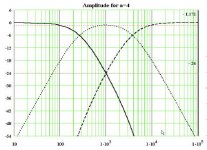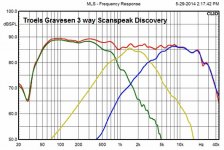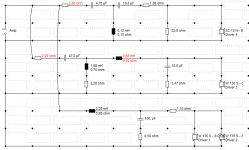Well, this was a real success so far: I lose a bit of efficiency obviously, but it sounds like the new configuration takes a potato out of the mouth of the singers. Also in songs like "With or without you" by U2, the bass notes tend to merge after a while with the original crossover. With the new they stay separate.
I keep asking: why is not an option to connect the woofer. In series?
Thanks,
D.
I keep asking: why is not an option to connect the woofer. In series?
Thanks,
D.
I got brave and removed all the glue, so now everything is more flexible. I want to backfit the new circuit on the board. I can do some modifications to the mid, but not all.
I am sure they are correlated. What I can do at the moment would be:
1) remove C6 from the mid
2) move l4 in the place of L2
3) install the 2.2 resistors on mid and tweeter.
I can remove C7 and R11, but I have no replacement for L3
Does it make sense to do 1 2 3 without tacked L3 ?
Thanks,
D.
I am sure they are correlated. What I can do at the moment would be:
1) remove C6 from the mid
2) move l4 in the place of L2
3) install the 2.2 resistors on mid and tweeter.
I can remove C7 and R11, but I have no replacement for L3
Does it make sense to do 1 2 3 without tacked L3 ?
Thanks,
D.
Dear System7,
For the 0.68 mH coil, did you have some specific item in mind ?
Should it be cored or in air ?
If the DCR is lower than what you indicated, can I add a series resistor, if needed ?
Thanks,
Davide
For the 0.68 mH coil, did you have some specific item in mind ?
Should it be cored or in air ?
If the DCR is lower than what you indicated, can I add a series resistor, if needed ?
Thanks,
Davide
It's all a bit experimental, IMO. But like AllenB, I think it is possible to tune a crossover by ear. Good and informed ears, of course! 🙂
We are winging it a bit with the fairly unknown Sonus Faber mid. The 0.33mH or 0.68mH midrange rolloff coil might as well be just any old aircore, because we like aircore rather than non-linear ferrites in theory. They are cheap enough at this value. Any DC resistance is not really a problem, but is likely to be less than 0.5R. It is compensated elsewhere.
TBH, I don't know how this will turn out. I think we discussed the possibility of replacing the mid with something more conventional by SEAS. But that is the last option IMO. "If it ain't broke, don't fix it..." is good engineering advice IMO. 😀
We are winging it a bit with the fairly unknown Sonus Faber mid. The 0.33mH or 0.68mH midrange rolloff coil might as well be just any old aircore, because we like aircore rather than non-linear ferrites in theory. They are cheap enough at this value. Any DC resistance is not really a problem, but is likely to be less than 0.5R. It is compensated elsewhere.
TBH, I don't know how this will turn out. I think we discussed the possibility of replacing the mid with something more conventional by SEAS. But that is the last option IMO. "If it ain't broke, don't fix it..." is good engineering advice IMO. 😀
I got brave and removed all the glue, so now everything is more flexible. I want to backfit the new circuit on the board. I can do some modifications to the mid, but not all.
I am sure they are correlated. What I can do at the moment would be:
1) remove C6 from the mid
2) move l4 in the place of L2
3) install the 2.2 resistors on mid and tweeter.
I can remove C7 and R11, but I have no replacement for L3
Does it make sense to do 1 2 3 without tacked L3 ?
Thanks,
D.
I have done the changes 1,2 and 3. I compromised on 2 ohm resistor for 3.
The quick listen that I could have like this tells me that the mid section sounded better as original. The present configuration is an hybrid, so maybe it down not make sense.
Frankly, I could live with what I heard this morning (only bass section modified and 2 ohm resistor on mid and high)
I'll order the coils tomorrow. Any other components that It might be good to have the in hand?
D
TBH, Davide, most of the problems I saw were the peaky "single note" bass.
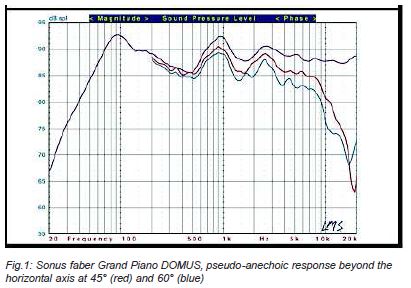
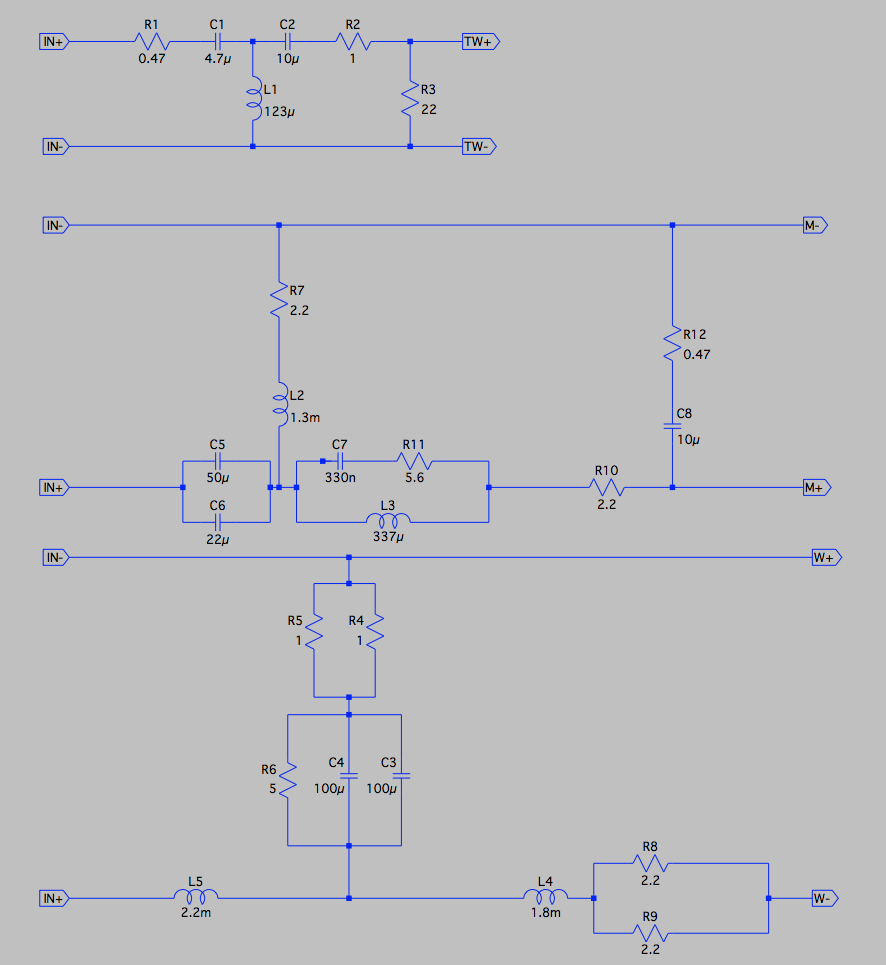
Ideas:
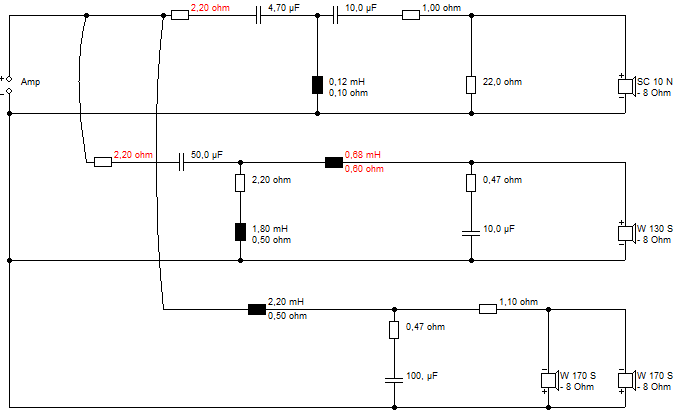
The steeper 0.68mH mid rolloff coil might be a waste of time, but an inexpensive experiment. 😀
What I hope you might take away from this is that you can adjust things if they aren't working for you. It's a fun hobby where the individual can take control. We have a good theory how it works, below.


Ideas:

The steeper 0.68mH mid rolloff coil might be a waste of time, but an inexpensive experiment. 😀
What I hope you might take away from this is that you can adjust things if they aren't working for you. It's a fun hobby where the individual can take control. We have a good theory how it works, below.
Attachments
Dear System7,
I am taking away a lot from this experience. I am doing some diyaudio since 2009. I have been building, in order, valve amplifiers, DACs, solid state amps (Pass labs), headphone amplifiers, preamplifiers and two pairs of full range speakers, but I did not realize how much "voicing" is in this crossover business. The impact of a resistor in a crossover is much more dramatic than any other change I have experience with the electronic.
Now we come to the "Philosophical" matter, if this should be done to the liking or aiming to the flatter response. In the latter case, I don't see any other way than going to rigorous measurements. So I think I have a lot of interesting readings in front of me and I really would appreciate also some tips on books to start with. Internet is a good source, but I always like to have some reference text.
Coming back to the Sonus faber crossover, I order some resistors, polypropylene caps and a set of air coils, so that I should be able to replace all the coils with air coil. I have the option to use the new and the old mid. (As I always say: "I need a critical mass of junk")
I think the order will be here the beginning of next week and there will be some interesting listening time in front of me. I spent a bit more that the minimum, but like this I can really setup some A/B test and choose a final configuration. I was thinking to leave the bi-amping option open when I reassemble the all thing.
I'll have some time to play with the simulations, while I wait for components.
Thanks,
Davide
I am taking away a lot from this experience. I am doing some diyaudio since 2009. I have been building, in order, valve amplifiers, DACs, solid state amps (Pass labs), headphone amplifiers, preamplifiers and two pairs of full range speakers, but I did not realize how much "voicing" is in this crossover business. The impact of a resistor in a crossover is much more dramatic than any other change I have experience with the electronic.
Now we come to the "Philosophical" matter, if this should be done to the liking or aiming to the flatter response. In the latter case, I don't see any other way than going to rigorous measurements. So I think I have a lot of interesting readings in front of me and I really would appreciate also some tips on books to start with. Internet is a good source, but I always like to have some reference text.
Coming back to the Sonus faber crossover, I order some resistors, polypropylene caps and a set of air coils, so that I should be able to replace all the coils with air coil. I have the option to use the new and the old mid. (As I always say: "I need a critical mass of junk")
I think the order will be here the beginning of next week and there will be some interesting listening time in front of me. I spent a bit more that the minimum, but like this I can really setup some A/B test and choose a final configuration. I was thinking to leave the bi-amping option open when I reassemble the all thing.
I'll have some time to play with the simulations, while I wait for components.
Thanks,
Davide
Last edited:
I'm a bit of a heretic when it comes to loudspeakers. 😱
The fact is that all loudspeakers are a LIE. But few are willing to admit this. 😀
Nothing we do with them gets near the original sound of live music and nature.
It's built into the uncertainty principle of Nature.
Your WWMT Sonus Faber speakers are a promising intro to good sound, because 3-ways work well enough, and certainly better than 2-ways. But really a good pair of headphones work better.
Nevertheless, it's worth working towards a good sound IMO. You surely don't think this anonymous design entity called "Sonus Faber" is really the last word? I think we as enlightened individuals might improve things. But perfection, forget about it. 😀
The fact is that all loudspeakers are a LIE. But few are willing to admit this. 😀
Nothing we do with them gets near the original sound of live music and nature.
It's built into the uncertainty principle of Nature.
Your WWMT Sonus Faber speakers are a promising intro to good sound, because 3-ways work well enough, and certainly better than 2-ways. But really a good pair of headphones work better.
Nevertheless, it's worth working towards a good sound IMO. You surely don't think this anonymous design entity called "Sonus Faber" is really the last word? I think we as enlightened individuals might improve things. But perfection, forget about it. 😀
Dear Steve,
Would you be so kind to send me the file you used for the simulations of the Sonus Faber with Boxsim ? I am starting to play with it, but there are many initial parameters that you can probably guess much better than me. The tool looks very powerful.
My e-mail is davide (dot) parise (at) gmail (dot) com
Regards,
Davide
Would you be so kind to send me the file you used for the simulations of the Sonus Faber with Boxsim ? I am starting to play with it, but there are many initial parameters that you can probably guess much better than me. The tool looks very powerful.
My e-mail is davide (dot) parise (at) gmail (dot) com
Regards,
Davide
That's strange. You have the measurement gear and the original drivers
in a box of your interest. You should be learning how to make measurements
ready for a simulation, not asking Visaton driver files.
in a box of your interest. You should be learning how to make measurements
ready for a simulation, not asking Visaton driver files.
It's a different thing: with sim I can play while in duty travel, waiting for boarding etc. with measurements I can only play while home with low noise floor (read no kids around). 🙂
D
D
That's strange. You have the measurement gear and the original drivers
in a box of your interest. You should be learning how to make measurements
ready for a simulation, not asking Visaton driver files.
Speaking of this, did anybody tried the USB mic that is sold on the miniDSP site ? It looks like it has calibration certificates and comes with an attractive price tag.
I would really like to set a reliable measurement setup, also to have it as support in speaker placement, after I have settled on the crossover.
Thanks,
Davide
Finally listening to the final results. I can say I am very satisfied. I kept the provision for bi-amping, in case I decide to go that way. Probably slightly bright, but this might be easy to change. One thing I notice is that now the imaging is much easier to achieve.
I 'll post the details of the filter, as built.
I 'll post the details of the filter, as built.
I think you've done very well here. IMO, the coils are a uncomfortably close to each other, which might cause some interaction, but the levels are easily adjusted with the red resistors.

Troels' 3 way discovery is not dissimilar, even down to the ring-radiator tweeter, which seems a good design.
ScanSpeak-3W-Discovery
A bit of BBC dip is indicated. If it sounds bright. But close to a wrap and some hot-glue maybe.

Troels' 3 way discovery is not dissimilar, even down to the ring-radiator tweeter, which seems a good design.
ScanSpeak-3W-Discovery
A bit of BBC dip is indicated. If it sounds bright. But close to a wrap and some hot-glue maybe.
Attachments
Here it is "As Built".
The way I mounted things, I can add resistance to both Mid and tweeter at the binding post, so it's easy to make some fine tuning. If I have to address tweeter and mid separately, I'll have to pull the crossover out. I think I've better wait a bit, listen and make some measurements, then reconsider.
There are some SEAS W15CY001 for sale. I was thinking that it might not be a bad idea to have them, at least we know their parameters. What do you think ?
Thanks,
Davide
The way I mounted things, I can add resistance to both Mid and tweeter at the binding post, so it's easy to make some fine tuning. If I have to address tweeter and mid separately, I'll have to pull the crossover out. I think I've better wait a bit, listen and make some measurements, then reconsider.
There are some SEAS W15CY001 for sale. I was thinking that it might not be a bad idea to have them, at least we know their parameters. What do you think ?
Thanks,
Davide
Attachments
- Status
- Not open for further replies.
- Home
- Loudspeakers
- Multi-Way
- Sonus Faber Grand Piano Domus
